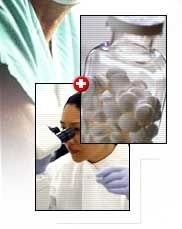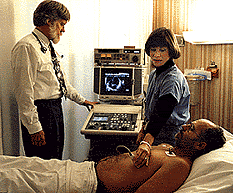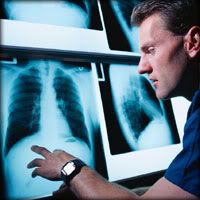Gene Therapy for Pulmonary Diseases.
Gene therapy, the replacement of defective or absent genes within the cell, or gene therapeutics, the use of transient administration of genes to affect function or modulate responses, are approaches to the treatment of pulmonary diseases that are gaining credibility.
Cystic fibrosis (CF) and [alpha]1-antitrypsin deficiency are diseases that are associated with single gene defects and represent the obvious rationale for gene therapy of replacing the defective or absent gene. Chronic acquired respiratory disorders such as COPD, asthma, or interstitial lung diseases are considered to be the product of a variety of endogenous (polygenic) and exogenous influences, and less obviously are associated with gene replacement therapy. These chronic inflammatory conditions likely arise from an imbalance between destructive and protective mechanisms, such that transient gene therapy, or gene therapeutics, can be useful to reconstitute a homeostatic balance by the short-term overexpression of protective genes or the suppression of damaging genes. In a similar manner, recent advances in cancer biology have identified a number of tumor-associated antigens, and these can be targeted by cell-based and gene-based therapeutic vaccines for immunotherapy interventions in patients with lung cancer.
Vectors and Barriers to Gene Delivery to the Lung and Airway
A number of different viral and nonviral vector systems are in use to transfer genes to lung tissue, most notably to the epithelial cells of the large and small airways. All show certain advantages and disadvantages. Entry to the parenchyma is considered to be more difficult and less effective, so that most recent efforts have been directed at making the transfer to the epithelium more efficient and less inflammatory, and having extended expression. The airways contain several epithelial cell types, including ciliated cells, mucus-secreting goblet cells, Clara cells, and basal epithelial cells. An excellent series of studies by Pickles indicated that the mucociliary clearance system and the glycocalyx are two serious innate barriers to vector exposure to the epithelial cell surface. The glycocalyx is thought to hold virus at a distance to the epithelium and to make it available for uptake and destruction by alveolar macrophage. Recent studies have shown that the use of a temporary water-induced hypoosmotic shock permeabilizes the glycocalyx and epithelium sufficiently to allow access to the tight junctions of the epithelium, leading to efficient uptake. Currently, the most common vectors used for gene transfer to the lung are replication-deficient adenoviruses and synthetic liposome/DNA complexes, but advances in adeno-associated virus (AAV) and lentivirus vector technology place these vector systems in a complementary aspect for successful gene transfer.
Liposomes are attractive, as by themselves liposomes appear to be nonimmunogenic. However, when used in gene therapy (ie, with plasmids inside), they generate a significant immune response, probably triggered by the CpG sequences in the vector, and while repeated delivery is feasible, the overall efficiency of transgene expression is low. Newer attempts to improve nonviral transfer systems have included the use of glycoconjugates and polyplexes, targeting serpin-enzyme complex receptors, polyethyleneimine and nanoparticle formulations, and the modulation of CpG motifs in the plasmids themselves. A recent approach combined the directability of liposome preparations, such as dexamethasone spermine and dioleoylphosphatidylethanolamine, with the content and efficiency of viral vectors to shepherd the viral vector to the appropriate site in the lung and to help entry to the cell, accompanied by reduced inflammation with the presence of a steroid.
The major advantages of adenovectors are their excellent efficiency in gene transfer, which has been demonstrated in numerous systems. However, gene expression is transient, and the immunogenicity of the human adenovirus (serotypes Ad2 and Ad5) prevents efficient readministration. Extended expression can be seen using a fully deleted helper-dependent vector, the so-called gutless adenovirus, which also reduces the extent of the immune response. However, the preparation is technically demanding and thus limited in scope, although this approach was recently used to allow the readministration of adenovirus vectors to mouse lung, suggesting that such strategies may be useful for humans. A more useful approach involves the development of nonhuman adenovirus vectors, such as serotypes from primates and other animals, which allow administration to humans who are immune to the human serotypes and thus readministration when needed. However, transfer efficiency limitations persist, as the attachment/entry receptors reside primarily on the basolateral surfaces of the epithelial cells and efforts must be made to redirect the specificity of vector-cell interaction or retargeting of the vector (eg, through alteration to the capsid coat of the vector).
AAV vectors have shown broad specificity of infection and prolonged expression in lung tissue. The vectors are thought to exhibit less inflammatory and immune reactions than the adenovirus. However, the small cloning capacity, the difficulty in achieving high titers during manufacturing, and the lack of efficiency in human trials still limits this system for lung gene transfer, although success with safe repeat aerosol administration to humans is a welcome development. As described for the adenovirus, some developments have involved several isoforms of the human AAV (ie, AAV2, AAV5, and AAV6), with AAV5 being more efficiently taken up by epithelial cells than AAV2. Moreover, there are other species of AAV that have recently been described such as a nonhuman primate isotype rh10, all of which allow isotype switching to avoid immune blocking and readministration to further extend the expression of genes in the lung.
Retrovirus and lentivirus vectors are able to transfect epithelial cells in culture; however, their use in vivo in the lung has been limited because of the need to deliver very high titers to effect reasonable levels of expression. In addition, retrovirus requires dividing cells for integration, while lentivirus, based on HIV and pseudotyped with the vesicular stomatitis virus (VSV) glycoprotein, can readily transfer to nondividing cells. Similar to adenovirus, the target for VSV glycoprotein interaction is at the basolateral surface of the epithelium, and transfer is inefficient. However, using the envelope glycoprotein from Ebola (Ebo) virus to pseudotype lentivirus vectors, a marked uptake of the vector through the apical surface of the epithelium is achieved in the murine lung, suggesting that this may result in a long-term expression system for the human lung.
Given the potential for beneficial intervention through the introduction of biologically important genes to the lung, further developments are needed in generating better and more efficient vectors and methods to circumvent the innate barriers of the lumen. New approaches may include the use of bone marrow-derived cells that have been modified to carry beneficial genes and induced to repopulate the epithelium, as was recently shown in patients who had undergone cross-gender transplantation of the lung and showed the presence of host-derived cells in the epithelium.
The lung is an attractive organ for gene transfer, because of its accessibility from both airways and vasculature. The transfer of genes via the airway results in gene expression mainly in lung epithelial cells, and the transgene is compartmentalized to the lung without much in the way of systemic distribution. In contrast, the IV application of genes transduces predominantly endothelial cells. Depending on the underlying disease, either route of administration, or even a combination of both, might be advantageous in the targeting of the lung.
CF (Cystic fibrosis)
Since the discovery of the CF transmembrane receptor (CFTR) gene in 1987, CF has been considered the major lung disease for intervention through gene therapy. To date, more than 10 clinical trials have been reported without showing a convincing restoration of function. Several reasons can be considered for this failure. (1) The ideal vector system has not yet been developed. Adenoviral vectors, AAV, and liposomes have been shown to transfer sufficient amounts of gene to the lung, but expression is always transient and the levels of expression are never high enough or lasting. The problems associated with repeat administration are yet unsolved, as has been mentioned. It has been shown that a third dose of adeno-CFTR administered 3 months after the first did not result in any further gene expression. A trial investigating the repeat administration of AAV-CFTR is currently underway. (2) The answers to the questions of which pulmonary region and which cells are the best target for CF gene therapy still must be elucidated. Clinical observations have shown that CF is initially localized in small airways, which are likely not within reach by the aerosols currently in use. Mucous plugs and local infections may be real obstacles for gene transfer. The main target tissue for gene transfer is the superficial epithelium, which exhibits all ion transport functions of CFTR and is best accessible via the topical administration of vectors. However, the constitutively highest level of CFTR gene expression is localized in bronchial submucosal gland cells. These glands may be better accessed by the vasculature and systemic vector application.
Another attempt to deliver gene vectors to these cells is to use adjuncts that can open tight junctions between surface epithelial cells (eg, sodium caprate). (3) The replacement of the CFTR gene in the airways alone will probably not compensate for all functional defects in CF patients. Data from the past few years have also suggested an impaired ability to clear bacterial airway infections, partly due to malfunctioning antimicrobial peptides (eg, human [beta]-defensin 1). Gene transfer could be used to deliver cytokines to the lung as an adjuvant therapy and thereby support the host response against bacteria. In pneumonia models, the survival of animals was improved by transient transgene expression of interleukin (IL)-12 and interferon (IFN)-[gamma], resulting in enhanced clearance of Klebsiella pneumoniae and Pseudomonas aeruginosa. This fact has important clinical relevance because of the increasing antibiotic resistance of P aeruginosa, which persistently colonizes airways in almost all CF patients.
[alpha]1-Antitrypsin Deficiency
[alpha]1-antitrypsin deficiency is a second pulmonary disease with an underlying single gene defect and a target for gene therapy. It is still unclear whether the replacement of [alpha]1-antitrypsin in patients with emphysema affects the course of the disease. Most attempts at gene replacement have been unsuccessful because of the short-term expression and the high concentrations of protein required for therapeutic efficacy. Recently, however, using a nonhuman primate serotype of AAV, high levels of the persistent expression of [alpha]1-antitrypsin were seen in mice, even if there was preexisting immunity to human AAV.
COPD and Asthma
Although we are not aware of any directed research in gene therapy for COPD, several possibilities are imaginable. Currently, the most accepted theory for the development of COPD is protease/antiprotease imbalance similar to emphysema due to hereditary [alpha]1-antitrypsin deficiency. Newer studies have shown that the pathogenesis of COPD involves not only elastases but also collagenases and gelatinases. Thus, the reestablishment of the balance by overexpressing antiprotease genes is theoretically beneficial, and the levels of antiproteases required should be lower, as in patients with [alpha]1-antitrypsin deficiency. Experimental models have suggested a role for [alpha]1-antitrypsin and secretory leukoprotease inhibitor in the treatment of this disorder. However, there is still need for a convincing study proving the concept of antiprotease treatment for COPD and emphysema. Neutrophils are a major source of proteases and reactive oxygen, and, because of their overabundance in COPD, gene therapy could also target adhesion molecules for neutrophils to reduce the influx of inflammatory cells into the lung parenchyma.
The benchmark for all future treatments of asthma are inhaled corticosteroids and bronchodilators, which are an established therapy for the majority of asthmatic patients. Gene therapy is not likely to be an alternative in the near future for these patients except for the concept of immunomodulation by gene-based vaccines. However, transient gene therapy could bring some benefit for asthmatic patients with severe disease who require high doses of systemic corticosteroids and for patients with corticosteroid-resistant asthma. T-helper (Th) type 1 cytokines are able to suppress Th2 cytokine reactions, and hence the overexpression of these mediators could be beneficial in the treatment of asthma. It has been shown that the gene transfer of IL-12 inhibits allergic airways disease by the suppression of the Th2 response to aerosolized ovalbumin. Interestingly, the overexpression of IL-12 also restored local antiviral immunity, which is impaired in a Th2-dominated environment. This observation has important clinical relevance when we consider that patients with obstructive airways disease often experience exacerbations during viral infections. In a similar study, the local or systemic gene transfer of IFN-[gamma] significantly inhibited allergen-induced airway hyperresponsiveness. Another potential area for gene therapy might be in patients with steroid-resistant asthma. A study has shown that the transfer of the glucocorticoid receptor gene in vitro mediated the inhibition of nuclear factor-[kappa]B activities even in absence of exogenous corticosteroids, and the authors suggested that this approach could restore corticosteroid sensitivity in patients.
Cell and Gene Therapy of Lung Cancer
This is a newer area of development with gene-based vaccines and immunotherapy of lung cancers. Here, access to the tumor is limited, and the intent is to stimulate the host immune response against unknown antigenic epitopes expressed by cancer cells in an effort to control cell growth and metastases. A nonviral vector expressing IL-12 was administered through intranasal instillation in mice to inhibit lung metastatic growth of osteosarcoma, while a granulocyte-macrophage colony-stimulating factor, gene-modified, autologous tumor cell vaccine elicited vaccine-induced immune activation in patients with advanced-stage non-small cell lung cancer. Adenovirus vectors have been used to deliver intrapulmonary IFN-[beta] to mice bearing an orthotopic graft of bronchogenic adenocarcinoma of the lung and to deliver suicide genes (herpes simplex virus thymidine kinase) to the pleural space in patients with malignant pleural mesothelioma, eliciting some surprising clinical responses. These are examples of developments that will increase as the efficacy and specificity of gene transfer to the lung increases.
Summary
Gene therapy is a promising new treatment for patients with lung diseases. Not only are patients with single gene disorders such as CF potential candidates for gene therapy, but also those with cancer and chronic lung diseases that are characterized by an imbalance of damaging and protective mechanisms. Numerous experimental models have shown that gene therapy is not a theoretical concept but is a realistic therapeutic goal. The first clinical trials in CF patients, which started almost 15 years ago, have not met expectations, mainly because of “immature” gene transfer and vector systems. However, it is anticipated that these hurdles will be overcome in the foreseeable future with the development of new vector systems and formulations allowing penetration to the epithelium, making gene therapy a feasible therapeutic alternative in patients with lung disease.




0 Comments:
Post a Comment
<< Home